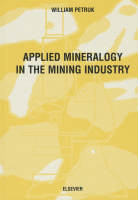Browse content
Table of contents
Actions for selected chapters
- Full text access
- Book chapterAbstract only
Chapter 1 - General principles of applied mineralogy
Pages 1-26 - Book chapterAbstract only
Chapter 2 - Instruments for performing applied mineralogy studies
Pages 27-49 - Book chapterAbstract only
Chapter 3 - Mineralogical characteristics and processing of massive sulfide base metal ores from the Bathurst-Newcastle mining area
Pages 51-71 - Book chapterAbstract only
Chapter 4 - Volcanogenic base metal deposits in the Flin Flon-Snow Lake areas, Manitoba, Canada
Pages 73-101 - Book chapterAbstract only
Chapter 5 - Relationships between mineral characteristics and flotability
Pages 103-109 - Book chapterAbstract only
Chapter 6 - Applied mineralogy related to gold
Pages 111-133 - Book chapterAbstract only
Chapter 7 - Applied mineralogy: Porphyry copper deposits
Pages 135-147 - Book chapterAbstract only
Chapter 8 - Mineralogical characteristics and processing of iron ores
Pages 149-183 - Book chapterAbstract only
Chapter 9 - Applied mineralogy investigations of industrial minerals
Pages 185-199 - Book chapterAbstract only
Chapter 10 - Applied mineralogy to tailings and waste rock piles-sulfide oxidation reactions and remediation of acidic water drainage
Pages 201-225 - Book chapterNo access
References
Pages 227-257 - Book chapterNo access
Subject index
Pages 259-264 - Book chapterNo access
Mineral index
Pages 265-268
About the book
Description
Techniques of performing applied mineralogy investigations, and applications and capabilities of recently developed instruments for measuring mineral properties are explored in this book intended for practicing applied mineralogists, students in mineralogy and metallurgy, and mineral processing engineers.
The benefits of applied mineralogy are presented by using in-depth applied mineralogy studies on base metal ores, gold ores, porphyry copper ores, iron ores and industrial minerals as examples. The chapter on base metal ores includes a discussion on the effects of liberation, particle sizes and surfaces coatings of Pb, Cu, Fe, Ca and So4- on the recoveries of sphalerite, galena and chalcopyrite. The chapter on gold discusses various methods of determining the quantities of gold in different minerals, including 'invisible' gold in pyrite and arsenopyrite, so that a balance of the distribution of gold among the minerals can be calculated. This book also discusses the roles of pyrite, oxygen, moisture and bacterial (thiobacillus ferrooxidans) on reactions that produce acidic drainage from tailings piles, and summarizes currently used and proposed methods of remediation of acidic drainage.
Techniques of performing applied mineralogy investigations, and applications and capabilities of recently developed instruments for measuring mineral properties are explored in this book intended for practicing applied mineralogists, students in mineralogy and metallurgy, and mineral processing engineers.
The benefits of applied mineralogy are presented by using in-depth applied mineralogy studies on base metal ores, gold ores, porphyry copper ores, iron ores and industrial minerals as examples. The chapter on base metal ores includes a discussion on the effects of liberation, particle sizes and surfaces coatings of Pb, Cu, Fe, Ca and So4- on the recoveries of sphalerite, galena and chalcopyrite. The chapter on gold discusses various methods of determining the quantities of gold in different minerals, including 'invisible' gold in pyrite and arsenopyrite, so that a balance of the distribution of gold among the minerals can be calculated. This book also discusses the roles of pyrite, oxygen, moisture and bacterial (thiobacillus ferrooxidans) on reactions that produce acidic drainage from tailings piles, and summarizes currently used and proposed methods of remediation of acidic drainage.
Details
ISBN
978-0-444-50077-9
Language
English
Published
2000
Copyright
Copyright © 2000 Elsevier B.V. All rights reserved
Imprint
Elsevier Science
